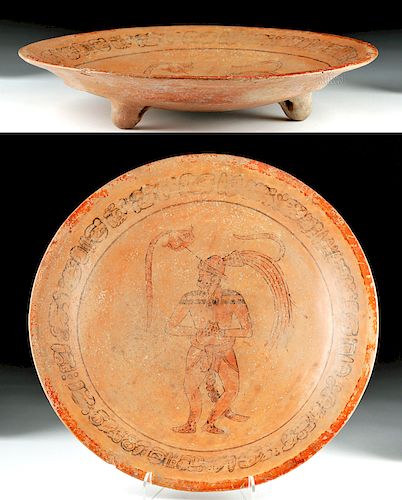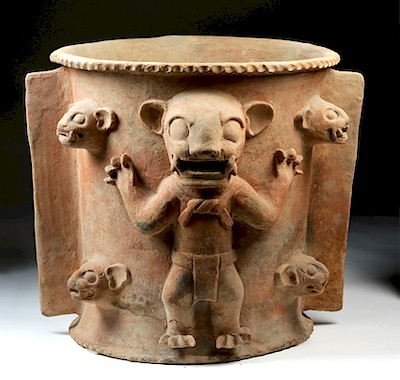Mayan Polychrome Tripod Dish - Water Lily Jaguar
Lot 142a
About Seller
Artemis Gallery
686 S Taylor Ave, Ste 106
Louisville, CO 80027
United States
Selling antiquities, ancient and ethnographic art online since 1993, Artemis Gallery specializes in Classical Antiquities (Egyptian, Greek, Roman, Near Eastern), Asian, Pre-Columbian, African / Tribal / Oceanographic art. Our extensive inventory includes pottery, stone, metal, wood, glass and textil...Read more
Estimate:
$2,000 - $3,000
Absentee vs Live bid
Two ways to bid:
- Leave a max absentee bid and the platform will bid on your behalf up to your maximum bid during the live auction.
- Bid live during the auction and your bids will be submitted real-time to the auctioneer.
Bid Increments
| Price | Bid Increment |
|---|---|
| $0 | $25 |
| $300 | $50 |
| $1,000 | $100 |
| $2,000 | $250 |
| $5,000 | $500 |
| $10,000 | $1,000 |
| $20,000 | $2,500 |
| $50,000 | $5,000 |
| $100,000 | $10,000 |
| $200,000 | $20,000 |
About Auction
By Artemis Gallery
Dec 6, 2018
Set Reminder
2018-12-06 10:00:00
2018-12-06 10:00:00
America/New_York
Bidsquare
Bidsquare : DAY 2 : Pre-Columbian, Ethnographic & Fine Art
https://www.bidsquare.com/auctions/artemis-gallery/day-2-pre-columbian-ethnographic-fine-art-3699
Day 2 of an important 2-dy auction featuring ancient and ethnographic art from around the world. Today's sale will feature Pre-Columbian, Native American, African / Tribal, Ethnographic, Spanish Colonial, Fine Art, much more. Artemis Gallery info@artemisgallery.com
Day 2 of an important 2-dy auction featuring ancient and ethnographic art from around the world. Today's sale will feature Pre-Columbian, Native American, African / Tribal, Ethnographic, Spanish Colonial, Fine Art, much more. Artemis Gallery info@artemisgallery.com
- Lot Description
Pre-Columbian, Mexico and northern Central America, Mayan Territories, Late Classic, ca. 550 to 900 CE. A large polychrome plate standing on three short conical legs, with a hand-painted jaguar warrior in tondo, standing in composite profile and wearing a jaguar mask, jaguar pelt gloves, and jaguar pelt foot coverings, and presenting a long wild feline tail. In addition, a series of glyphs surrounds the figure, tracing the interior rim. Also note the waterlily attached to the front extension from the figure's helmet (feathered plumes flowing behind the helmet); this suggests the Water Lily Jaguar (also known as Jaguar Night Sun, the Jaguar War God, and JGU), Jaguar God of the Underworld (Xibalba), possibly an aspect of the Sun God - the sun at night when progressing through the underworld, thus associated with the moon. The Jaguar God of the Underworld was also associated with war - echoed by the jaguar warrior figure depicted on this plate; the Jaguar God of the Underworld is also represented on a warrior shield on the "Tablet of the Sun" at Palenque. Size: 13.75" in diameter x 2.5" H (34.9 cm x 6.4 cm)
King of Beasts in the Pre-Columbian world, infamous for possessing high speed and massive strength, the jaguar was believed to dominate nature inspiring respect and awe throughout the ancient Americas. Jaguars were also associated with strength and leadership, whether in regard to spirituality or martial skill. Warriors, rulers, hunters, and shamans alike associated themselves with this King of Beasts, the largest and most powerful feline in the New World whom they viewed as their spirit companion and protector. In addition, scholars believe that the jaguar is associated with fertility and vegetation by the Maya. The Waterlily Jaguar or Jaguar God of the Underworld is depicted with waterlilies sprouting from its head connoting fertility.
For the Maya, finely decorated ceramic works like this example were gifted to elite individuals, akin to the gifts exchanged between high profile dignitaries today. Painted Mayan pottery like this was used for feasting, ritual purposes, and as prestigious gifts given to emphasize the power of the giver and bind the recipient to giver through a form of purchased loyalty. Maya kings and queens oftentimes gave them to local governors. In addition, the artists who created them were also often minor royalty or nobility, especially the ones who could paint glyphs as literacy was reserved for the Mayan elite.
Follow this link to see a rollout of a vessel depicting the Jaguar God of the Underworld in the Metropolitan Museum of Art in New York that comes from Guatemala, ca. 500 to 700 CE - https://ancientmayalife.blogspot.com/2018/01/the-jaguar-god-of-underworld.html
Provenance: private Southern California, USA collection, acquired in the 1970s to mid-1980s
All items legal to buy/sell under U.S. Statute covering cultural patrimony Code 2600, CHAPTER 14, and are guaranteed to be as described or your money back.
A Certificate of Authenticity will accompany all winning bids.
We ship worldwide and handle all shipping in-house for your convenience.
#140772One stabilized pressure crack from rim. Surface wear with some fading to the painted decorative program and abraded areas as shown. Legs possibly reattached.Condition
- Shipping Info
-
All shipping is handled in-house for your convenience. Your invoice from Artemis Gallery will include shipping calculation instructions. If in doubt, please inquire BEFORE bidding for estimated shipping costs for individual items.
-
- Buyer's Premium



 EUR
EUR CAD
CAD AUD
AUD GBP
GBP MXN
MXN HKD
HKD CNY
CNY MYR
MYR SEK
SEK SGD
SGD CHF
CHF THB
THB
















